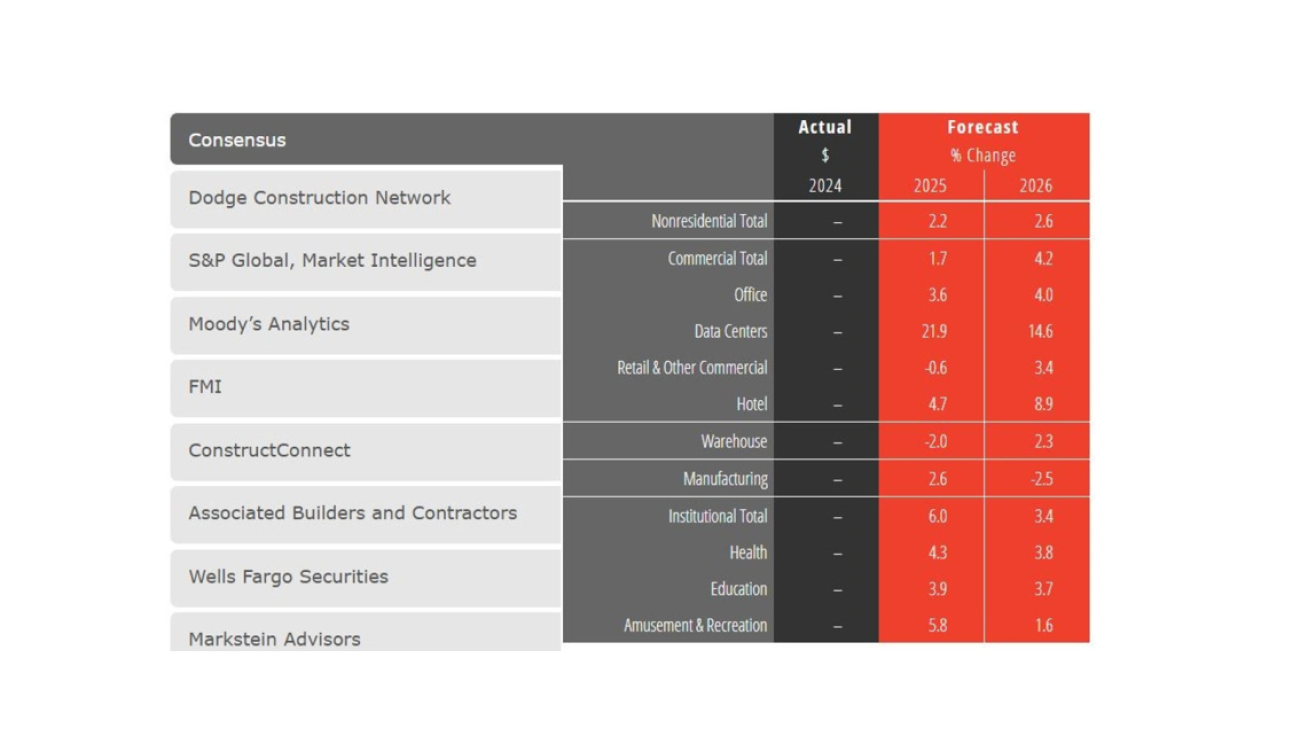The construction industry enters 2026 carrying the weight of a volatile 2024–2025: high financing costs, uneven activity across subsectors, and an explosive, capital-intensive buildout of data-center and semiconductor capacity.
Across residential and nonresidential markets the story is one of divergence — pockets of outsized investment (data centers, institutional facilities, some infrastructure) versus broad weakness or stagnation in traditional office, some retail, and parts of multifamily — all against a backdrop of persistent labor shortages and supply-chain sensitivity.
The near-term path for the sector will be driven by how quickly financing conditions relax, how much hyperscalers actually scale back or continue capex, and how public funding filters into projects on the ground.
An overview:
- Updates
- Residential construction forecast
- Commercial construction forecast
- Construction trends
- What to expect
- Key takeaways
- How did we do with our last forecast?
Updates
By mid-August 2026, U.S. construction shows mixed recovery as mortgage rates ease and single-family starts rebound after two down years. Mortgage rates have begun to ease from their mid-2024 peaks, leading to a modest uptick in buyer traffic.
This improvement is driving a measured rebound in single-family housing starts after two challenging years of decline. However, builder confidence remains fragile, with industry sentiment recovering only gradually from the prolonged low plateau experienced throughout 2024 and 2025.
On the commercial side, hyperscale data-center investment continued to dominate new private capex announcements, while traditional office and many retail projects remained constrained by tight corporate budgets and subpar absorption. Institutional (healthcare/education) and public infrastructure work sustained activity as federal and state funding flows continued to be deployed.
Macro drivers shaping H1–H2 2026
- Rates and lending: Short-term policy rates drifted lower into 2026 (aided by softer inflation) but 30-year mortgage rates remained elevated in the mid-6% band for many buyers — enough to sustain affordability pressure and keep household formation and turnover subdued.
- Capital concentration: Large cloud and hyperscale players continued to allocate massive capex to compute and campus facilities; this concentrated construction dollars into a narrow set of commercial projects.
- Labor & materials: Labor pipelines remained tight for skilled trades, and selective material price spikes (steel, electrical components) kept cost uncertainty baked into bids and contract clauses.
Residential Construction Forecast
Single-family starts — trajectory
After post-2021 cycle highs, single-family starts dipped through 2023–2024 as affordability tightened. Heading into 2026 the consensus from government and industry data points to a partial recovery in single-family activity: starts are expected to bottom and trend upward as mortgage rates moderate and builders work through excess speculative inventories in several markets. The monthly series remain volatile, but annualized figures signal a modest rebound from trough levels.Demand drivers and drag factors
Drivers
- Pent-up household formation: Demographic momentum (younger cohorts entering prime housing ages) and continued migration to Sun Belt and suburban markets support demand for single-family housing.
- Institutional capital & build-to-rent (BTR): Institutional investors remain active buyers of newly built single-family product, creating a parallel demand channel and supporting starts in select geographies.

Drags
- Mortgage affordability: Elevated mortgage rates (mid-6% range unless a recession forces a sharper cut) suppress resale turnover and buyer purchasing power, keeping many would-be sellers “rate-locked.”
- Builder sentiment & inputs: Low NAHB builder confidence suggests builders will stay cautious and target product where absorption and margins are clearest.
Expect stronger starts in lower-cost Sun Belt metros and suburban single-family outside high-priced coastal cores. Higher-end speculative building will lag until mortgage spreads compress; modular and production builders who control labor and supply chains will grow share where they can preserve margins.
Commercial construction forecast
Big picture: divergence not uniform growth
Nonresidential construction is fragmented. Overall spending is forecast to grow slowly in 2026, but that headline masks winners (data centers, institutional, select industrial/logistics) and losers (traditional office, some retail). Activity will be concentrated in a few hyper-performing niches even as many legacy commercial segments remain subdued.
Data centers and hyperscale compute
The scale of hyperscaler capex is historic and concentrated: cloud providers and AI platform operators are planning multiyear investments in compute, power, and campus-scale facilities that represent one of the largest allocations of private capital to a single building type in recent memory. That pipeline underpins strong regional demand for specialized commercial shells, substation upgrades, and heavy electrical/mechanical contractor work.
The Financial TimesMeta is building “Prometheus” and “Hyperion”, Elon Musk’s xAI has “Colossus”, and OpenAI is developing “Stargate” — each a more than $100bn project to build the world’s most powerful supercomputer and usher in a new generation of artificial intelligence.
But each of those gargantuan ventures is just a fraction of the spending required to build the data centres needed to power the AI era: one of the biggest movements of capital in modern history.
Office, retail, and hospitality
- Office: Weak net absorption and rising vacancy persist. Some firms are consolidating or upgrading spaces with higher-spec HVAC and collaboration-first design, but new office construction remains limited except for adaptive reuse and high-spec redevelopment.
- Retail & hospitality: Selective bright spots (experience-led retail, last-mile logistics) exist, but broad retail expansion is slow as consumer spending patterns normalize unevenly.
See also: What is the future of the corporate HQ?
Institutional and infrastructure
Institutional work (healthcare, education) is a relative bright spot — public and non-profit funding supports projects — and infrastructure / transportation benefits from continued legislative funding and state matching programs.
Spending outlook
Consensus panels expect modest, low-single-digit gains for construction spending in 2026, with the strongest growth concentrated in institutional and specialized industrial segments (including the data-center complex).

Construction trends
- Capital concentration into tech-centric assets: The AI/data-center buildout has redirected material, labor, and capital to a narrow set of commercial projects — increasing competition for grid capacity and specialized contractors. Expect regional winners (cheap power, permitting efficiency) and losers.
- “Higher for longer” financing and contract design: With elevated interest rates, owners and contractors manage risk through tighter underwriting, more conservative leverage, inflation-linked clauses, and larger contingencies. Procurement strategies and contract forms are evolving accordingly.
- Workforce constraints and productivity plays: An aging trades base and slow inflow of new workers sustain upward wage pressure and limit capacity. Contractors who invest in productivity (prefab, modular, digital workflows) will win time and margin advantages.
- Sustainability, resiliency & regulation: Owners increasingly demand energy-efficient, resilient systems. Regulatory and lender pressure will make green building and lifecycle cost analysis standard in many bids.
- Policy & trade uncertainty: Tariffs, immigration policy, and supply-chain frictions can cause rapid margin shocks for contractors who import materials or rely on migrant labor. Firms are building policy risk explicitly into pricing and supply strategies.
What to expect
Expect modest industry growth in 2026, concentrated in a handful of high-capital commercial segments and steady institutional and infrastructure work funded by public budgets — while broad residential recovery will be gradual and uneven, highly dependent on mortgage rate trajectories and local affordability economics.
- Overall spending: Low single-digit growth (rough consensus ~1–4%), with engineering and select industrial/data-center work outpacing general commercial.
- Residential: Single-family starts likely to recover modestly through 2026 as rates moderate; multifamily completions may slow from 2024–2025 peaks.
- Commercial: Data centers and specialized institutional projects will be the primary private-sector growth engines; office and traditional retail will remain challenged.
- Risks: Faster-than-expected rate cuts (positive for housing) or an unexpected macro slowdown (negative across the board); tariffs or material shocks; localized permitting or grid constraints that slow hyperscale projects.
Key takeaways
- Winner-take-most commercial capex: Hyperscale data centers and semiconductor/fab projects are concentrating capital and skilled contractor capacity, distorting the nonresidential landscape.
- Residential recovery is conditional: Single-family starts should climb modestly if mortgage rates ease from mid-6% territory; persistent high rates limit upside.
- Slow but not collapsing: Consensus forecasts show low single-digit growth in 2026 — not a boom, but not a broad contraction either.
- Labor & supply constraints: Workforce shortages and material volatility make productivity investments (modular, digital tools) competitive differentiators.
- Regional winners outperform: Cheap power, fast permitting and robust household growth determine local activity outcomes.
- More conservative contracting: Escalation clauses, stronger contingencies and explicit risk allocation become standard procurement features.
- Institutional & infrastructure as a floor: Public budgets and institutional capital provide resilience even when private spending slows.
- Watch capital re-allocation risk: Overinvestment in narrow asset classes could create stranded asset risk if demand or technology pivots.
How did we do with our last forecast?
Our original 2025 Construction Outlook identified many correct long-run dynamics — labor scarcity, the importance of infrastructure spend, and pockets of growth — but it was too optimistic overall in its near-term aggregate growth expectations.
What actually happened (mid-2025 evidence)
- Slower put-in-place growth than expected. U.S. construction put-in-place spending increased only ~1–2% year-over-year in 2025, well below the optimism embedded in earlier scenarios.
- Residential shock. The most pronounced miss was in residential: high mortgage rates and affordability headwinds produced a sharper contraction in resale activity and slower absorption of new product than anticipated; NAHB readings showed prolonged low builder confidence.
- Fragmented nonresidential outcome. Data centers and a few institutional niches drove much of the spending while core office and many retail segments languished — creating wide dispersion beneath a moderate headline.
Why we were off
Higher-for-longer interest rates persisted longer than some scenarios assumed. Capital concentration (AI/data centers) accelerated, redirecting a disproportionate share of nonresidential dollars.
Policy & supply shocks (tariff talk, supply-chain re-routing, local permitting constraints) introduced more cost and schedule uncertainty than modeled in our central case.
Methodology note & sources
This outlook synthesizes government releases (Census/HUD monthly starts and permits), industry consensus forecasts (AIA Consensus Construction Forecast, FMI), sector research (JLL data-center outlook), market reporting (Financial Times, Forbes, BuildingRadar), and association data (NAHB HMI). The list below includes the primary source families cited in this report.Sources:
- https://realestate.usnews.com/real-estate/housing-market-index/articles/housing-market-predictions-for-the-next-5-years
- https://www.aia.org/about-aia/press/softness-construction-spending-predicted-through-2026-consensus-construction
- https://www.buildingradar.com/construction-blog/emerging-trends-shaping-us-commercial-construction-in-2025-2026
- https://www.forbes.com/sites/billconerly/2025/02/06/2025-26-construction-forecast-chips-and-data-centers-lead-others-lag/
- https://www.ft.com/content/3db51ec0-4c69-4bff-ae23-33e932deee86
- https://www.ft.com/content/efe1e350-62c6-4aa0-a833-f6da01265473
- https://www.hpac.com/industry-perspectives/article/55307230/consensus-construction-forecast-predicts-sluggish-2026
- https://www.nahb.org/news-and-economics/press-releases/2025/08/builder-confidence-plateaus-at-relatively-low-level

